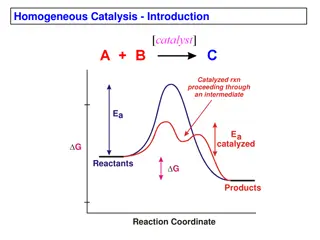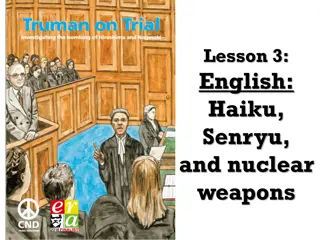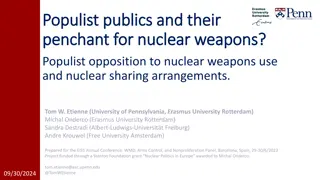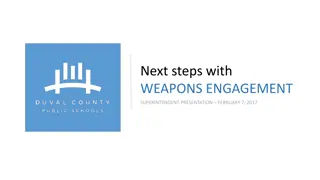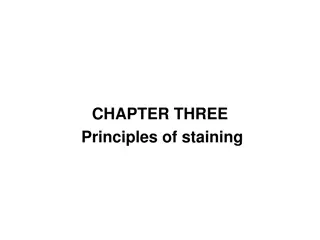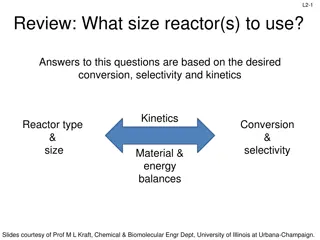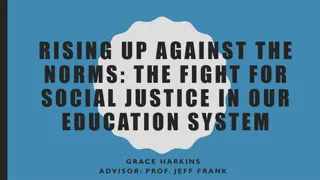International Norms and Weapons Regulation: Analyzing the Selectivity of Bans
International norms exhibit selectivity in banning certain weapons like landmines and blinding laser weapons while permitting others such as depleted uranium-based arms and autonomous killer robots. The discrepancy raises questions about ethical outrage in weapon condemnation and the role of agenda-vetting organizations in shaping global attitudes towards different arms. The study explores the dynamics of weapon regulation within the framework of international law, humanitarian norms, and the human security network.
Download Presentation

Please find below an Image/Link to download the presentation.
The content on the website is provided AS IS for your information and personal use only. It may not be sold, licensed, or shared on other websites without obtaining consent from the author. Download presentation by click this link. If you encounter any issues during the download, it is possible that the publisher has removed the file from their server.
E N D
Presentation Transcript
Carpenter, International Organizations, 2011 International Norms oppose landmines and blinding laser weapons, but not weapons based on depleted uranium or autonomous killer robots. Why? April 1, 2019 POLI 421, Framing Public Policies 1
Why do we ban some weapons but not others? Chemical warfare widely condemned Also: landmines, cluster mines, small arms proliferation But: Thermobaric weapons (fuel-air explosives, create huge fireballs to suffocate and burn people) Psychotropic weapons: mood altering aerosols The puzzle: Ethical outrage about certain weapons but not others POLI 421, Framing Public Policies 2
Agenda-vetting and gatekeeper organizations Same theory as last time Idea of the norms entrepreneur similar to last time as well Cases analyzed are different: weapons POLI 421, Framing Public Policies 3
International law and the law of war The Hague Conventions and the Geneva Convention generally restrict certain types of actions in warfare. (These rules, of course, have limited power, but the point is that they reflect an international consensus that war should be conducted in certain ways, not others.) So, what is barred, and what is allowed? POLI 421, Framing Public Policies 4
Table 1, salience of various weapons in the human security network Top issues: Landmines, cluster munitions, small arms, disarmament (nuclear), chemical weapons. Medium issues: nuclear, biological, nonlethal weapons, arms trade, remnants Issues not on anyone s agenda: Depleted uranium weapons, directed energy, blinding lasers, white phosphorous, autonomous weapons, psychotropic, thermobaric, explosive weapons, napalm POLI 421, Framing Public Policies 5
Major players in the Human Rights Network World Heath Organization International Committee of the Red Cross Human Security Network Org. for Security and Cooperation in Europe Human Rights Watch International Crisis Group Stockholm Peace Research Institute Etc. POLI 421, Framing Public Policies 6
Figure 3, selecting 4 cases for study POLI 421, Framing Public Policies 7
Landmines Used by the millions in virtually every war Jody Williams, International Campaign to Ban Landmines, won Nobel Peace Prize 1973 beginning of advocacy to limit them 1991: activists seek to ban them completely 1992 Human Rights Watch got on board 1997, Princess Diana, Nelson Mandela, the Pope, Queen Noor 1997, 122 nations sign a Mine Ban Treaty POLI 421, Framing Public Policies 8
Blinding Lasers US, UK, USSR militaries develop these weapons in the 1980s Maybe dazzle or disorient the pilots of attacking planes, use in anti- aircraft defense missiles and surface to air guns . Or maybe just make lots of people go blind 1986 Sweden and Switzerland propose a ban at the UN 1996, prohibition of lasers designed specifically to blind POLI 421, Framing Public Policies 9
Depleted Uranium Developed by the major powers in the 1960s, armor piercing weapons to penetrate tanks, bunkers, etc. Gulf War, Kosovo (1990s), some concern about health effects Campaign Against Depleted Uranium starts in the UK in 1999 No action at all POLI 421, Framing Public Policies 10
Autonomous Weapons Different from drones, which have a controller in Tampa or Orlando or somewhere else actually driving the thing and shooting the weapons These are robots with guns, and no human participation Not the same as a booby-trap or a trip-wire Use artificial intelligence to see a threat and respond with lethal force All major governments have developed these No success in banning these POLI 421, Framing Public Policies 11
How would you frame a ban on killer robots? How would the other side counter? POLI 421, Framing Public Policies 12


